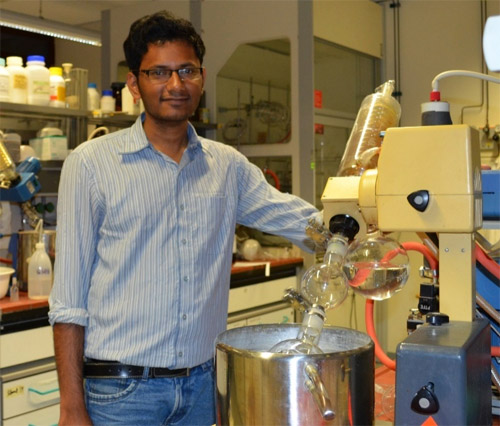 A recipient of the Inspire Faculty Award instituted by the Department of Science and Technology, Govt. of India, Dr. Debabrata Samanta from Department of Chemistry at Indian Institute of Technology, Kanpur is working to design and synthesize new materials to harvest sunlight as an alternative source of energy.
A recipient of the Inspire Faculty Award instituted by the Department of Science and Technology, Govt. of India, Dr. Debabrata Samanta from Department of Chemistry at Indian Institute of Technology, Kanpur is working to design and synthesize new materials to harvest sunlight as an alternative source of energy.
Dr. Samanta, in his recent work, has developed a water-splitting photocatalyst utilizing earth-abundant elements. The catalyst has been found to produce hydrogen from water with high efficiency and can be a future source of green energy.
The ever-increasing energy demand of our society and the rapid decline of non-renewable energy sources urgently requires the development of alternative energy sources. To overcome the energy crisis, researchers are constantly designing and synthesizing new and better materials to harvest sunlight as an alternative source of energy.
The visible-light-induced photocatalytic hydrogen generation through water oxidation has received enormous interest as hydrogen serves as a source of energy with high energy density and a clean energy material.
In an efficient catalyst, a fine-tuning between the polarization and the charge carrier mobility is desirable in an efficient photocatalyst. The water-splitting photocatalyst(TPA-Zn) triphenylamine zinc developed by Dr. Samantha produces green energy from the water with high efficiency. Therefore, the research can help in producing low-cost green energy.
Dr. Samantha synthesised a donor-acceptor coordination polymer TPA-Zn by Zn(II)-assisted self-assembly of an in situ generated triphenylamine (TPA). The TPA units act as a donor, and the Zn (II)-coordinated terpyridine units act as an acceptor. The coordination polymer showed visible light absorption and exhibited hydrogen evolution from the water with a final amount of 55.6 millimoles/gram (mmol/g) within 16 h upon full range light irradiation (290 - 750 nm). It also produced 30.1 mmol/g hydrogen within 16 h under simulated visible light (420 – 750 nm).
The recyclability of the catalyst was tested upto seven cycles, revealing excellent stability of TPA-Zn under the reaction condition. The integrity of the metal complex after performing the photocatalysis was supported by various analyses. Moreover, the morphology was also intact after the photocatalysis.
Dr. Samantha said that the long-term plan is developing a low-cost catalyst which converts water into green fuel (H2) easily. This will help to reduce pollution by replacing carbon dioxide emitting fossil fuels.
For more details please contact: Dr. Debabrata Samanta, Email: dsamanta87[at]gmail[dot]com






























